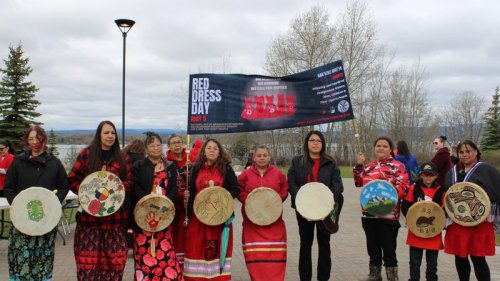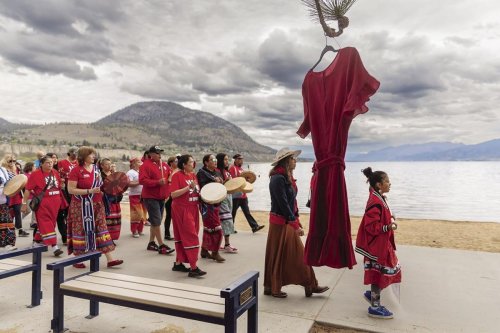Every year on May 5th, Canada marks Red Dress Day, also known as the National Day of Awareness for Missing and Murdered Indigenous Women, Girls, and Two-Spirit (MMIWG2S) people. More than just a date on the calendar, Red Dress Day is a powerful symbol of remembrance, a stark reminder of the systemic violence plaguing Indigenous communities, and a rallying cry for justice and change. The visual impact of empty red dresses hanging in public spaces serves as a poignant and unforgettable representation of the thousands of Indigenous women and girls who have gone missing or been murdered, their absence leaving a gaping hole in their families, communities, and the fabric of Canadian society.
This article delves into the history, significance, and impact of Red Dress Day, exploring the complex issues surrounding MMIWG2S, the movement for justice, and the ongoing need for awareness and action.

The Genesis of a Powerful Symbol: The Red Dress Project
The origins of Red Dress Day can be traced back to the powerful art installation, "The REDress Project," created by Métis artist Jaime Black. Black's inspiration stemmed from a conversation with a friend who mentioned that spirits are only able to recognize us in the spirit world by the color red. She began collecting red dresses and installing them in public spaces, primarily in Canada, to represent the missing and murdered Indigenous women and girls.
The empty red dresses, flapping gently in the wind, became a potent symbol of the absence, the loss, and the enduring presence of the women and girls they represent. The project aimed to create a visible reminder of the staggering statistics and the ongoing crisis of MMIWG2S, sparking conversations, raising awareness, and demanding action.
Understanding the MMIWG2S Crisis: A Complex Web of Systemic Issues

The crisis of MMIWG2S is deeply rooted in the colonial history of Canada and the ongoing systemic discrimination faced by Indigenous people. Generations of oppression, forced assimilation, displacement, and cultural destruction have created vulnerabilities that contribute to the disproportionately high rates of violence experienced by Indigenous women, girls, and two-spirit individuals.
Several factors contribute to this complex issue, including:
- Poverty and socio-economic disparities: Indigenous communities often face higher rates of poverty, unemployment, and lack of access to resources, increasing vulnerability to violence and exploitation.
- Geographical isolation: Many Indigenous communities are located in remote areas with limited access to essential services such as healthcare, policing, and social support, hindering prevention efforts and responses to violence.
- Historical trauma: The legacy of residential schools, forced relocation, and cultural suppression has resulted in deep-seated trauma within Indigenous communities, contributing to cycles of violence and substance abuse.
- Lack of adequate policing and justice: Systemic biases and lack of cultural understanding within the justice system often lead to inadequate investigations, lower conviction rates, and a lack of accountability for crimes against Indigenous people.
- Racism and sexism: Indigenous women and girls face both racism and sexism, making them particularly vulnerable to violence and exploitation. They are often stereotyped and dehumanized, contributing to a lack of empathy and concern for their safety.
- Intergenerational trauma: The trauma experienced by previous generations of Indigenous people is often passed down to subsequent generations, perpetuating cycles of violence and disadvantage.
Red Dress Day: A Call to Action and a Space for Healing

Red Dress Day is more than just a day of remembrance; it's a call to action, a platform for advocacy, and a space for healing and solidarity. On this day, communities across Canada and beyond participate in various activities to raise awareness, honor the lives of MMIWG2S, and demand action from governments and institutions.
These activities include:
- Displaying red dresses: Red dresses are hung in public spaces such as parks, schools, community centers, and government buildings, creating a visual reminder of the missing and murdered Indigenous women and girls.
- Organizing marches and rallies: Marches and rallies are held to raise awareness of the MMIWG2S crisis, demand justice, and call for policy changes.
- Holding ceremonies and vigils: Ceremonies and vigils are organized to honor the lives of MMIWG2S, provide a space for grieving and healing, and offer support to families and communities.
- Educational events and workshops: Educational events and workshops are held to raise awareness of the historical and systemic factors contributing to the MMIWG2S crisis, promote cultural understanding, and empower individuals to take action.
- Advocacy and lobbying: Individuals and organizations engage in advocacy and lobbying efforts to pressure governments and institutions to implement the recommendations of the National Inquiry into Missing and Murdered Indigenous Women and Girls.
- Sharing stories and amplifying voices: Red Dress Day provides a platform for Indigenous women, girls, and two-spirit individuals to share their stories, amplify their voices, and advocate for their rights.
The National Inquiry and the Path to Justice
The National Inquiry into Missing and Murdered Indigenous Women and Girls, which concluded in 2019, was a landmark investigation that documented the systemic causes of violence against Indigenous women, girls, and two-spirit individuals in Canada. The Inquiry's final report, containing 231 Calls for Justice, provides a comprehensive roadmap for addressing the MMIWG2S crisis and achieving justice for Indigenous communities.
These Calls for Justice call for a fundamental shift in the relationship between Indigenous peoples and the Canadian state, demanding systemic changes in areas such as child welfare, policing, justice, healthcare, and education. They also call for greater cultural understanding, respect for Indigenous rights, and the implementation of concrete actions to prevent violence and ensure the safety and well-being of Indigenous women, girls, and two-spirit individuals.

Beyond Red Dress Day: Sustaining the Momentum for Change
While Red Dress Day is a crucial event for raising awareness and mobilizing action, it is essential to sustain the momentum for change throughout the year. Addressing the MMIWG2S crisis requires a long-term commitment to systemic change, ongoing advocacy, and a willingness to listen to and learn from Indigenous communities.
Here are some ways to contribute to the ongoing efforts to address the MMIWG2S crisis:
- Educate yourself: Learn about the history of colonialism in Canada, the systemic issues contributing to the MMIWG2S crisis, and the experiences of Indigenous people.
- Listen to Indigenous voices: Seek out and listen to the stories and perspectives of Indigenous women, girls, and two-spirit individuals.
- Support Indigenous organizations: Donate to and volunteer with Indigenous organizations working to address the MMIWG2S crisis.
- Advocate for policy changes: Contact your elected officials and advocate for the implementation of the National Inquiry's Calls for Justice.
- Challenge racism and sexism: Speak out against racism and sexism in all its forms.
- Promote cultural understanding: Learn about Indigenous cultures and traditions and promote cultural understanding in your community.
- Support Indigenous businesses and artists: Support Indigenous businesses and artists to help strengthen Indigenous communities.
Conclusion: Remembering, Honoring, and Acting for Justice
Red Dress Day serves as a powerful and poignant reminder of the ongoing crisis of Missing and Murdered Indigenous Women, Girls, and Two-Spirit people. The empty red dresses speak volumes about the profound loss and the urgent need for justice and systemic change. By remembering the lives of those who have been lost, honoring their memory, and taking action to address the root causes of violence, we can work towards a future where all Indigenous women, girls, and two-spirit individuals are safe, respected, and valued. The fight for justice is ongoing, and it requires the collective effort of all Canadians to create a more equitable and just society for Indigenous peoples.
Word Count: 1,456

Ann Cinzar
Ann Cinzar lives in Ottawa, Ontario with her husband Mike, daughter Rosie, and their dog Reese. She is passionate about family life and loves Canada.






Leave a comment?
To write a comment, you must login or register first.